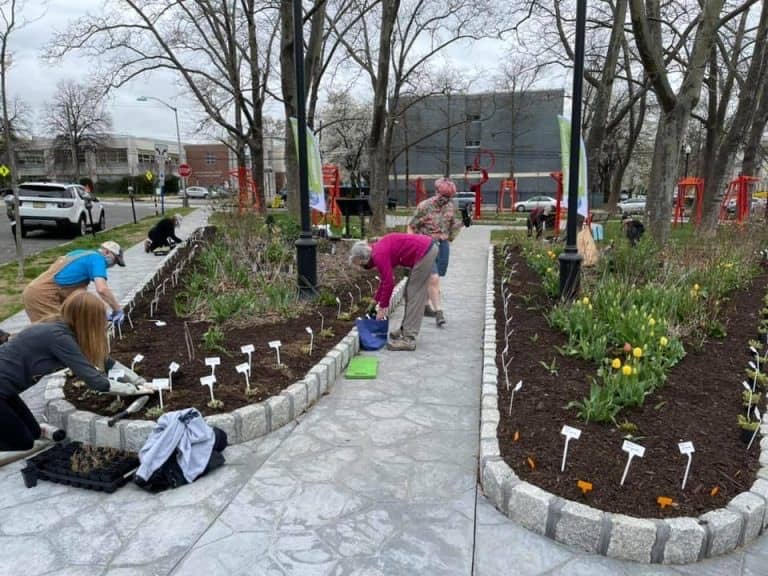“Leaving the leaves” should be the ultimate environmental goal. However, to prevent accidents on walkways and lawns, it’s advisable to rake them, doing so as gently as possible.
Raking eliminates the noise, noxious gases, and clouds of dust associated with other methods. Moreover, there’s no soil erosion, unlike when using leaf blowers.
While the process of leaf raking seems straightforward, it’s essential to understand safe and effective removal techniques. This ensures minimal disturbance to the beneficial insects wintering among the leaves.
The raking guide below targets younger volunteers of the “I Want To Mow Your Lawn” platform, or those inexperienced with raking. Ready to dive in?
Safety First:
- Double-check you’re at the correct address before starting. It may sound trivial, but mix-ups have occurred. Consider ringing the bell to introduce yourself before commencing. If the homeowner can’t physically meet due to disability, you’ll be informed beforehand.
- Dress appropriately: wear work gloves to avoid blisters and comfortable, grippy shoes since wet leaves can be slippery.
- Always store your rake vertically to avoid tripping hazards. Prop it against a fence or tree, and this holds true for other garden tools as well.
- Protect your eyes. Consider protective eyewear when raking near trees with low branches.
- Arrange for bathroom and water breaks elsewhere, perhaps at a nearby shop, rather than relying on the homeowner’s facilities.
- Refrain from smoking on the property. Dry leaves and lit cigarettes are a hazardous mix.
Let’s get raking:
Your primary objectives on any property are clearing leaves from the lawn and paths. Paths should be free from leaf build-up to avoid slip hazards, and excessive leaf layers can suffocate grass.
Before starting, ensure you have:
- A tarp for transporting large leaf piles.
- Leaf claws for picking up leaves (or use dry cardboard as a DIY alternative).
- Leaf bags, if bagging is necessary.
- A broom or an electric leaf blower for path clearance.
- Don’t forget gloves, suitable footwear, and eye protection. Sunblock and water might also be handy.
Start by clearing the walking paths and then pile the leaves on the lawn. Use your tarp to gather these leaves. Leave a thin layer of leaves around shrubs and trees for winter protection.
If the property has flower beds, it’s best to leave the leaves in place. They offer winter protection for plants and a haven for beneficial insects. However, if the leaf layer is too thick, gently handpick some away.
To reiterate, aside from ensuring clear paths and lawn areas, aim to “leave the leaves” where possible.
Think Ahead about Leaf Disposal:
Before raking, decide on a leaf disposal method:
- Leave them on the Property: Ideally, deposit raked leaves at the back of the lot. This enriches the soil over time. If this isn’t feasible, distribute a thin layer around shrubs and trees.
- Mulch Them: Electric mulchers or lawn mowers can break down leaves, which can then nourish flower beds or lawns. Note: this might affect insects using the leaves for shelter.
- Bag Them: This is the least eco-friendly option and requires the most effort. Minimize the amount you bag.
A Quick Tip for Opening Lawn Bags:
To easily open a lawn bag, partially open it and swiftly swing it side-to-side. The wind will do the rest. A special thanks to my gardening partner, Amy, for this tip! Amy’s Website
Who Lives in the Leaves?
According to the Xerces Society, most butterflies and moths spend the winter in various life stages among the leaves. This includes the Great spangled fritillary, wooly bear caterpillars, Red-banded hairstreaks, Luna moths, swallowtail butterflies, and many others. Read more here.
Our Last Word:
You might rake for someone unfamiliar with the concept of “leaving the leaves.” They might even hand you a leaf blower, expecting a leaf-free yard. If the situation permits, share your insights and best practices. After all, leaving the leaves benefits both the environment and reduces work for you.
Thank you for your commitment. Enjoy raking and your volunteering journey!
Signup to Volunteer Here!
